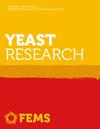Mitochondrial membrane transporters as attractive targets for the fermentative production of succinic acid from glycerol in Saccharomyces cerevisiae
IF 2.4
4区 生物学
Q3 BIOTECHNOLOGY & APPLIED MICROBIOLOGY
引用次数: 0
Abstract
Previously, we reported an engineered Saccharomyces cerevisiae CEN.PK113-1A derivative able to produce succinic acid (SA) from glycerol with net CO2 fixation. Apart from an engineered glycerol utilization pathway, the strain was equipped with the reductive branch of the TCA cycle (rTCA) and a heterologous SA exporter. However, the results indicated that a significant amount of carbon still entered the CO2-releasing oxidative TCA cycle. The current study aimed to tune down the flux through the oxidative TCA cycle by targeting the mitochondrial uptake of pyruvate and cytosolic intermediates of the rTCA pathway, as well as the succinate dehydrogenase complex. Thus, we tested the effects of deletions of MPC1, MPC3, OAC1, DIC1, SFC1, and SDH1 on SA production. The highest improvement was achieved by the combined deletion of MPC3 and SDH1. The respective strain produced up to 45.5 g/L of SA, reached a maximum SA yield of 0.66 gSA/gglycerol, and accumulated the lowest amounts of byproducts. Based on the obtained data, we consider a further reduction of mitochondrial import of pyruvate and rTCA intermediates highly attractive. Moreover, the approaches presented in the current study might also be valuable for improving SA production when sugars (instead of glycerol) are the source of carbon.线粒体膜转运体是酿酒酵母发酵生产甘油琥珀酸的诱人靶标
此前,我们报道了一种工程化的酿酒酵母 CEN.PK113-1A 衍生物,它能够利用甘油生产琥珀酸(SA),并具有净二氧化碳固定能力。除了改造甘油利用途径外,该菌株还配备了 TCA 循环的还原分支(rTCA)和异源 SA 导出器。然而,研究结果表明,仍有大量碳进入释放二氧化碳的氧化 TCA 循环。目前的研究旨在通过靶向丙酮酸的线粒体摄取和 rTCA 途径的细胞膜中间产物以及琥珀酸脱氢酶复合物来降低通过氧化 TCA 循环的通量。因此,我们测试了缺失 MPC1、MPC3、OAC1、DIC1、SFC1 和 SDH1 对 SA 产量的影响。MPC3和SDH1的联合缺失对SA产量的提高最大。该菌株的 SA 产量高达 45.5 克/升,最大 SA 产量为 0.66 克/克甘油,副产物积累量最低。根据所获得的数据,我们认为进一步减少线粒体丙酮酸和 rTCA 中间产物的输入极具吸引力。此外,当糖(而不是甘油)作为碳源时,本研究提出的方法可能对提高 SA 的产量也很有价值。
本文章由计算机程序翻译,如有差异,请以英文原文为准。
求助全文
约1分钟内获得全文
求助全文
来源期刊

FEMS yeast research
生物-生物工程与应用微生物
CiteScore
5.70
自引率
6.20%
发文量
54
审稿时长
1 months
期刊介绍:
FEMS Yeast Research offers efficient publication of high-quality original Research Articles, Mini-reviews, Letters to the Editor, Perspectives and Commentaries that express current opinions. The journal will select for publication only those manuscripts deemed to be of major relevance to the field and generally will not consider articles that are largely descriptive without insights on underlying mechanism or biology. Submissions on any yeast species are welcome provided they report results within the scope outlined below and are of significance to the yeast field.
 求助内容:
求助内容: 应助结果提醒方式:
应助结果提醒方式:


